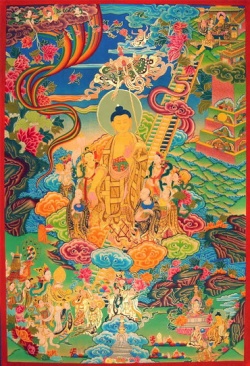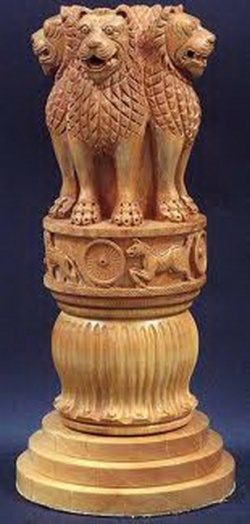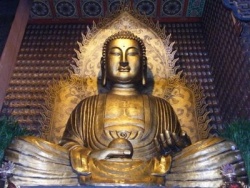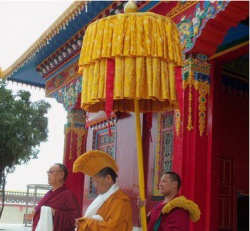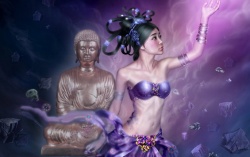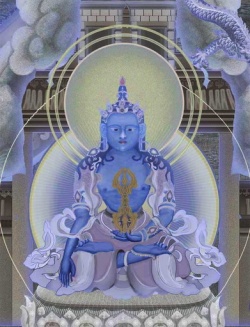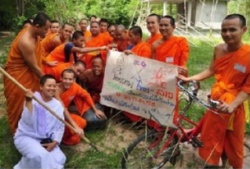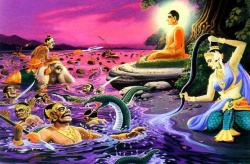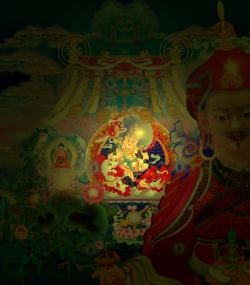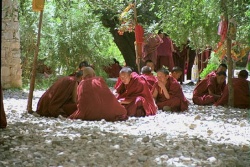Difference between revisions of "Mahayana Mahaparinirvana Sutra"
| Line 110: | Line 110: | ||
==In popular {{Wiki|culture}}== | ==In popular {{Wiki|culture}}== | ||
| − | *A section of the[[ Nirvana Sutra]] has an important role in the first [[chapter]] of the manga {{Wiki|Samurai}} Executioner by writer Kazuo Koike and artist Goseki Kojima. | + | *A section of the[[ Nirvana Sutra]] has an important role in the first [[chapter]] of the [[manga]] {{Wiki|Samurai}} Executioner by writer Kazuo Koike and artist Goseki Kojima. |
==English edition== | ==English edition== | ||
Revision as of 12:53, 10 March 2016
The Nirvana Sutra or Mahāparinirvāṇa Sūtra (Chinese: Nièpán Jīng (涅槃經); Japanese: Nehankyō (涅槃経); Standard Tibetan: myang 'das kyi mdo) is one of the major sutras of Mahayana Buddhism. It shares its title with another well-known Buddhist scripture, the Mahaparinibbana Sutta of the Pali Canon but is quite different in form and content. It is therefore generally referred to by its full Sanskrit title, Mahāyāna Mahāparinirvāṇa Mahā-sūtra or more commonly simply the "Nirvana Sutra".
The Nirvana Sutra mentions some of the well-known episodes in the final months of the life of the Buddha. The sutra uses these narratives as a springboard for the expression of Mahayana ideals. Its main teachings centre on the eternity of the Buddha, the reality of the True Self, and the presence of the Buddha-dhatu (Buddha Nature) in all beings.
Dating
Though not a specialist on this text, Paul Williams opines that as Mahayana sutra, it is of rather late date (after the 2nd century CE). In contrast to this view, specialist scholars believe that the compilation of the core portion (corresponding to the Faxian and Tibetan translations) must have occurred at an earlier date, during or prior to the 2nd century CE, based internal evidence and on Chinese canonical catalogs. Likewise, the Buddhist scholar and translator of the Tibetan version of the sutra, Stephen Hodge, speculates that it could well date from around 100CE to 220CE. Standard studies of the Buddha's life use the Mahaparinibbana Sutta as the principal source of reference.
Versions
Like the majority of Mahāyāna sūtras, the Nirvana Sutra evidently underwent a number of stages in its composition, which is of some importance for any discussion of the Tathāgatagarbha and Buddha-nature (buddha-dhātu) doctrines. A leading scholar in this field is the Japanese scholar Masahiro Shimoda, who posits a short proto-Nirvana Sutra, which was, he argues, probably not distinctively Mahāyāna, but quasi-Mahāsanghika in origin and would date to 100 CE, if not even earlier. He suggests that an expanded version of this core text was then developed and would have comprised chapters 1, 2, 3, 4, 6 and 7 of the Faxian and Tibetan versions, though it is believed that in their present state there is a degree of editorial addition in them from the later phases of development.
Sasaki (1999), in a review of Shimoda (1997), conveys a key premise of Shimoda's work, namely, that the origins of Mahayana Buddhism and the Nirvana Sutra are entwined.
Hodge (2004) frames the versions and history of the Nirvana Sutra:
There are three extant versions of the Mahāyāna-mahāparinirvāna-sūtra, each translated from various Sanskrit editions: the shortest and earliest is the translation into Chinese by Faxian and Buddhabhadra in six juan (418CE), the next in terms of development is the Tibetan version (c790CE) by Jinamitra, Jnanagarbha, and Devacandra, and the extended version in 40 juan by Dharmakshema (421-430) which was also translated into Tibetan from the Chinese. There also exists a secondary Chinese version in 36 juan of Dharmakshema's translation, produced by polishing the style and adding new section headings and completed in 453CE. It is also known from Chinese catalogues of translations that at least two other Chinese translations were done, slightly earlier than Faxian, but these are no longer extant. Though a complete version of the entire text in Sanskrit has not yet been discovered, some fragments of original Sanskrit versions have been discovered in [[Wikipedia:Central Asia|Central Asia]], Afghanistan and Japan.
The text of the Nirvana Sutra in the original Sanskrit has survived only in a number of fragments, which were discovered in [[Wikipedia:Central Asia|Central Asia]], Afghanistan and Japan. It does exist in Chinese and Tibetan versions of varying lengths. Faxian, the monk who initially brought the text to China from India, prepared a brief translation containing six fascicles, but Dharmakṣema's slightly later translation had forty fascicles. Still later, Huiguan, Huiyan, Xie Lingyun, and others during the Liu Song dynasty integrated and amended the translations of Faxian and Dharmakṣema into a single edition of thirty-six fascicles. That version is called the "southern text" of the Nirvana Sutra, while Dharmakṣema's version is called the "northern text." There is also a Tibetan translation, compiled in about 790 by the Indian panditas Jinamitra, Jnanagarbha and the Tibetan scholar-monk Devacandra, which is comparable in length to Faxian's translation. Thus, there are four extant versions:
- The "six fascicle text", translated during the Eastern Jin Dynasty by Buddhabhadra and Faxian between 416 and 418, T 376.12.853-899.
- The "northern text", with 40 fascicles, translated in the Northern Liang kingdom by Dharmakṣema between 421 and 430, T 374.12.365c-603c.
- The "southern text" with 36 fascicles, complied in the Liu Song Dynasty by Huiguan and Huiyan, in approximately 453, T 375.12.605-852.
- The "Tibetan text", translated in 8th century Tibet by Jinamitra, Jnanagarbha and Devacandra.
It is also known from Chinese catalogues of translations that at least two other Chinese translations were done, slightly earlier than Faxian, but these are no longer extant.
Transmission and Authenticity
According to scholars specializing in the Mahāyāna Mahāparinirvāṇa-sūtra, the history of the text is extremely complex, but the consensus view is that the core portion of this sutra corresponding to the Tibetan translation, the six juan Chinese translation attributed to Faxian and the first ten juan of the Dharmakṣema Chinese translation was compiled in the Indian sub-continent, possibly in Andhra, Southern India.
According to early Chinesesutra catalogues such as the Lidai Sangbao ji (歷代三寶紀), a part of the core portion of thesutra was translated previously into Chinese by Dharmarakṣa (fl. c260-280), though this version is now lost.
According to Faxian's own account, the manuscript copy forming the basis of the six juan Chinese version was obtained by him in Pāṭaliputra from the house of a layman known as Kālasena, during his travels in India. Though the translation of this six juan version is conventionally ascribed to Faxian(法顯), this attribution is probably inaccurate. Written less than 100 years after the date of this translation, the earliest surviving Chinesesutra catalogue, Sengyou's Chu Sanzang Jiji (出三藏記集), makes no mention of Faxian, but instead states that the translation was done by Buddhabhadra and his assistant Baoyun (寶雲). Sengyou quotes still earlier catalogues to corroborate this attribution. The idea that Faxian was involved in the translation only emerges in later catalogues, compiled several hundred years after the event.
Chinese canonical records also mention that a now lost translation was made by the Chinese monk Zhimeng who studied in India from 404-424 CE. According to Zhimeng's own account, he also obtained his manuscript from the same layman in Pataliputra as Faxian did some years earlier.
The surviving data for the translation done by Dharmakṣema from 421CE onwards in Guzang is somewhat confused and contradictory. However, based on the earliest biographical material, such as the account of his life given by Sengyou and Huijiao's "Record of Eminent Monks" (高僧傳 T2059), it seems that Dharmakṣema brought with him a birch-bark manuscript of the Mahāparinirvāṇa-sūtra from North-Western India, which he used for the initial translation work of his version. This is stated to have formed the basis of the first ten juan of his translation, known to correspond overall in content to the six juan version and the Tibetan version.
However, Dharmakṣema's translation of the Mahāyāna Mahāparinirvāṇa-sūtra extends for a further thirty juan beyond the accepted core text of this sutra. The provenance and authenticity of the Sanskrit text, if such existed, underlying this part of his translation has been debated amongst scholars for decades, with many doubting that it is a text of Indian origin. The chief reasons for this skepticism are these: no traces of a extended Sanskrit text has ever been found, while Sanskrit manuscript fragments of twenty four separate pages distributed right across the core portion of the Mahāparinirvāṇa-sūtra have been found over the past hundred years in various parts of Asia; no quotations are known from this latter portion in any Indian commentaries orsutra anthologies; and no other translator in China or Tibet ever found Sanskrit copies of this portion. The Chinese monk-translator Yijing travelled widely through India and parts South East Asia over a twenty-five year period. In his account of "Eminent Monks who Went West in Search of the Dharma" (大唐西域求法高僧傳 T2066), he mentions that he searched for a copy of the enlarged Mahaparinirvāṇa-sūtra through all that time, but only found manuscripts corresponding to the core portion of this work. For these reasons, textual scholars generally regard the authenticity of the latter portion as dubious: they surmise it may have been a local Central Asian composition at best or else written by Dharmakṣema himself who had both the ability and the motive for doing so. As a consequence, specialist scholars accept that this latter portion of the Mahāparinirvāṇa-sūtra translated by Dharmakṣema has no value for the history of the tathāgata-garbha concept and related doctrines during their development in India.
Buddha-nature and True Self
The Mahaparinirvana Sutra is a long and highly composite Mahayana scripture. It has been highly influential in the development of Chinese Buddhism, because of its statements on Buddha-nature and the True Self, which it seemed to reify. It presents itself as providing the correct understanding of earlier Buddhist teachings, controverting the familiar Buddhist dictum that "all dharmas phenomena are non-Self". Instead of emptiness and non-self it emphasizes the existence of a True Self.
Buddha-nature
Much of the central focus of theNirvana Sutra falls on the existence of the salvific Buddha-dhatu (Buddha-nature(佛性), Buddha element, or Buddha principle), also called the Tathagatagarbha(如來藏) ("Buddha-matrix" or "Buddha embryo"), in every sentient being (animals included - hence the Buddha's strong support for vegetarianism in this sutra). The full seeing of the Buddha-nature ushers in Liberation from all suffering, and effects final deliverance into the realm of Great Nirvana (maha-nirvana). This "True Self" or "Great Self" of the nirvanic realm is said to be sovereign, to be attained on the morning of Buddhahhood, and to pervade all places like space. The Buddha-dhatu is always present, in all times and in all beings, but is obscured from worldly vision by the screening effect of kleshas ( tenacious negative mental afflictions) within each being (the most notable of which are greed 貪, hatred 嗔, delusion 癡, and pride 慢). Once these negative mental states have been eliminated, however, the Buddha-dhatu is said to shine forth unimpededly and the Buddha-sphere (Buddha-dhatu/ visaya) can then be consciously "entered into", and therewith deathless Nirvana attained.
Non-self
"Non-Self" in the Mahaparinirvana Sutra refers to the impermanent, mundane, skandha-constructed ego, whose seeming reality is called by the Buddha "a lie" (in contrast to the true supramundane Selfhood of the Buddha).
The Buddha, in the Fa-xian version of the text, points out that worldly beings who misapprehend the authentic Buddhist Doctrine
... have the notion that there is no Self, and are unable to know the True Self.
Paul Williams claims it refers to the Buddha using the term "Self" in order to win over non-Buddhist ascetics.
True Self
In the Dharmakshema version the Buddha declares that
In truth there is Self (Atman) in all dharmas [which is] indestructible like a diamond
This self can assume all manner of forms, including those of the gods Shiva and Vishnu. It is eternal, unchanging, blissful, pure, inviolate and deathless:
... if the non-eternal is made away with in Nirvana, what there remains must be the Eternal; if there is no more any sorrow, what there remains must be Bliss; if there is no more any non-Self, what exists there must be the Self; if there is no longer anything that is impure, what there is must be the Pure
Earlier the Buddha taught non-Self to meet the needs of the occasion. In theNirvana Sutra he teaches the truth of the Self, which remains once the non-Self is done away with:
What the Buddha says here is that he spoke thus to meet the occasion. But now the thought is established [of non-Self, he means to say what is true, which is about the inner content of nirvana itself ... If there is no more any non-Self, what there exists must be the Self.
Tathagatagarbha
The idea of Buddha-nature is related to the tathagatagarbha, the émbryo of awakening'. The tathagatagarbha is the same as Thusness (tathata).
Yamamoto writes:
...the tathagatagarbha is none but Thusness or the Buddha Nature, and is the originally untainted pure mind which lies overspread by, and exists in, the mind of greed and anger of all beings. This bespeaks a Buddha Body that exists in a state of bondage. The attitude of approach here is ontological, religious, personal, and therefore, practical...
Eternal Buddha
The True Self is not the conditioned and transitory "self", but the Self-which-signifies-Buddha: all-knowing and all-pure Ultimate Reality, unconstrained by the limitations and illusions of samsara. This Self of the Buddha is the source of ever-enduring life.
Any idea that the Buddha (who is the immortal Self) is impermanent is vigorously rejected by the Buddha in this sutra, and those who teach otherwise are severely criticised. He insists:
Those who cannot accept that the Tathāgata is eternal [nitya] cause misery".
In contrast, meditating upon the eternality of the Buddha is said to bring happiness and protection from rebirth in evil realms. The eternal being of the Buddha should be likened - thesutra says - to indelible letters carved upon stone. Furthermore, protecting and promoting this teaching of the Buddha's eternity is said to bring innumerable and inconceivable blessings to its votaries.
The Buddha is likened to a great sea, whose expanse and longevity cannot be measured:
All the great rivers of life of all people, of the gods, the earth and the sky drain into the Tathagata's sea of life. Hence, the length of life of the Tathagata is uncountable.
What is the Tathagata Buddha … He is one who is eternal and unchanging. He is beyond the human notion of “is” or “is-not”. He is Thusness [tathata], which is both phenomenon and noumenon, put together. Here, the carnal notion of man is sublimated and explained from the macrocosmic standpoint of existence of all and all. And this Dharmakaya is at once Wisdom and Emancipation [moksha]. In this ontological enlargement of the concept of existence of the Buddha Body buddhakaya, thissutra and, consequently, Mahayana, differs from the Buddha of Primitive Buddhism … And what is the Dharmakaya? It is a body founded on Dharma. And what is Dharma? It is dharmata Thusness – the true nature of all things], which is eternal and which changes not …Thus, there comes about the equation of: Buddha Body = Dharmakaya = eternal body = eternal Buddha = Eternity. … What is Nirvana? [Dwelling upon the nature of Nirvana, the Buddha explains its positive aspects and says that Nirvana has four attributes, which are the Eternal, Bliss, the Self, and the Pure’.
Mahaparinirvana
The highest form of Nirvana—Mahaparinirvana—is also discussed in very positive, "cataphatic" terms in theNirvana Sutra. Mahaparinirvana is characterized as being that which is
Eternal (nitya), Blissful (sukha), the Self (atman) and Pure (subha)
This state or sphere (visaya) of ultimate awareness and Knowing (jnana) is said to be accessible only to those who have become fully awakened Buddhas. Even 10th-level Bodhisattvas (i.e. the very highest level of Bodhisattva) are not able clearly to perceive the Buddha-dhatu, and they further fail to see with clarity that the immutable, unfabricated Dhatu dwells indestructibly within all beings The longer versions of theNirvana Sutra additionally give expression to the new claim (not found in the shorter Chinese and Tibetan versions) that, because of the Buddha-dhatu, absolutely all beings without exception, even icchantikas (the most incorrigible and spiritually base of beings), will eventually attain Liberation and become Buddhas.
Quotations from the Nirvana Sutra
The Buddha on his eternal and blissful ultimate nature as he stands on the brink of physical death:
If you perceive things truly, you will become free from attachment, separated from them, you will indeed be liberated. I have well crossed the watery waste of existence. I abide in bliss, having transcended suffering, therefore I am devoid of unending desire, I have eliminated attachment and gained Liberation moksha. There is no old age, sickness or death for me, my life is forever without end. I proceed burning bright like a flame. You must not think that I shall cease to exist. Consider the Tathagata [i.e. Buddha to be like Mount Sumeru: though I shall pass into Nirvana here [i.e. physically die, that supreme bliss is my true nature dharmata.
On the eternal nature of the Buddha-Tathagata:
The Buddha-Tathagatas are not eternally extinguished in Nirvana like the heat of an iron ball that is quickly extinguished when cast into water. Moreover, it is thus: just as the heat of an iron ball is extinguished when thrown into water, the Tathagata is likewise; when the immeasurable mental afflictions have been extinguished, it is similar to when an iron ball is cast into water - although the heat is extinguished, the substance / nature of the iron remains. In that way, when the Tathagata has completely extinguished the fire of the mental afflictions that have been accumulated over countless aeons, the nature of the diamond Tathagata permanently endures - not transforming and not diminishing.
On his teaching of "non-Self" (the "worldly self", which ultimately does not exist eternally, but obscures the True Self) and the tathagata-garbha:
- When I have taught non-Self, fools uphold the teaching that there is no Self. The wise know that such is conventional speech, and they are free from doubts.
When I have taught that the tathagata-garbha is empty, fools meditatively cultivate [the notion] that it is extinction uccheda, subject to destruction and imperfect. The wise know that it is [actually] unchanging, stable and eternal.
- ... just as cow's milk is delicious, so too is the taste of this Nirvana Sutra similar to that. Those who abandon the teaching given in thissutra concerning the tathagata-garbha are just like cattle. For example, just as people who intend to commit suicide will cause themselves extreme misery, similarly you should know that those ungrateful people who reject the tathagata-garbha and teach non-Self cause themselves extreme misery. Tibetan version, translated by Stephen Hodge.
In contrast to the illusory, conditioned, worldly self, the Self of the Buddha is real and enduring:
The Tathagata's Body is not causally conditioned. Because it is not causally conditioned, it is said to have the Self; if it has the Self, then it is also Eternal, Blissful and Pure.
On the True Self:
The Tathagata also teaches, for the sake of all beings, that, truly, there is the Self in all phenomena.
TheNirvana Sutra in Mahayana Schools
Nichiren Buddhism
In Nichiren Buddhism theNirvana Sutra, with the Lotus Sutra make up what T'ien-T'ai called the Fifth of the Five Periods of Teaching. TheNirvana Sutra is seen as inferior to the Lotus Sutra however, based on the passage in the Nirvana Sutra that reads:
When thissutra was preached . . . the prediction had already been made in the Lotus Sutra that the eight thousand voice-hearers would attain Buddhahood, a prediction that was like a great harvest. Thus, the autumn harvest was over and the crop had been stored away for winter [when the Nirvana Sutra was expounded], and there was nothing left for it [but a few gleanings]."
In popular culture
- A section of theNirvana Sutra has an important role in the first chapter of the manga Samurai Executioner by writer Kazuo Koike and artist Goseki Kojima.
English edition
- The Mahayana Mahaparinirvana Sutra in 3 Volumes, tr. by Kosho Yamamoto, the Karinbunko, Ube City, Japan, 1973-1975.
- The Mahayana Mahaparinirvana Sutra in 12 Volumes, translated by Kosho Yamamoto and edited by Dr. Tony Page (Nirvana Publications, London, 1999–2000).
- Mahayanism: A Critical Exposition of the Mahayana Mahaparinirvana Sutra, by Kosho Yamamoto, The Karinbunko, Tokyo, 1975
- Buddha-Self: The Secret Teachings of the Buddha in the Mahaparinirvana Sutra by Dr. Tony Page, Nirvana Publications, London, 2003
